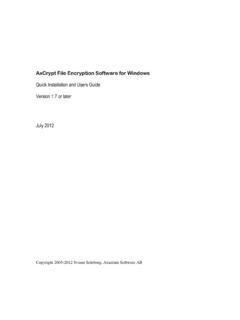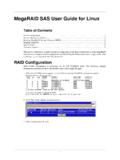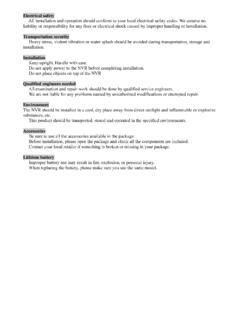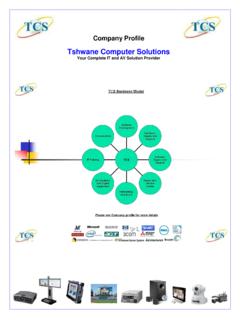Transcription of 128-Bit Versus 256-Bit AES Encryption
1 BackgroundThere is some confusion around the market for full disk Encryption (FDE) products. seagate Technology LLC has introduced a line of products that offer 128-AES Encryption . Some software and competitive hardware products offer 256-AES Encryption . The question is: Are the 256-AES product offerings better than comparable 128-AES products?To answer that question, it s necessary to define better. Given that we are talking about protecting data at rest, it s reasonable to define better to mean significantly more difficult for unauthorized parties to access the protected data. The short answer is no. Exhaustive key search techniques on a key space of 128 bits, using the latest streamlining processes, require resources (MIPS, memory, power and time) many orders of magnitude beyond current capabilities.
2 Any unseen breakthroughs would most certainly apply to 256-Bit as well as 128-Bit .(A brief explanation of the terms 128-AES and 256-AES: AES is a symmetric key algorithm. AES encrypts and decrypts data in 128-Bit blocks, using 128-, 192- or 256-Bit keys. AES nomenclature for the different key sizes is AES-x, where x is the key size.)To understand an attacker s path to data, we need to describe the system. The primary components of a data-at-rest security system are the authentication module and the Encryption applications, of course, include many management tools that vary by each installation. These tools may be used to generate or escrow passwords and keys and to track and establish users and their digital identities.
3 This paper will not delve into these management tools. Rather, the focus will be a discussion on the strength of security of the core components, namely the authentication module and the Encryption ModuleIt wouldn t make sense for someone to invest a million dollars on security measures for doors and windows and all other entry points in their home, but use a pass code of 1234 as the combination to open the front Versus 256-Bit AES EncryptionPractical business reasons why 128-Bit solutionsprovide comprehensive security for every needTechnology PaperAuthenticationModuleEncryptionEngin eThis exemplifies why maximizing security involves combining strong access controls to the system with strong secure processes for handling and processing data and the adage.
4 A chain is only as strong as its weakest the opening statement of this paper suggested confusion over Encryption key length, the latter portion of this paper should convince you that the Encryption engine strength should be of least concern, given the ingredients of the Encryption engines in question. With these Encryption engines in place, the real key (no pun intended) to strong security is to assure that the authentication portion of the system is at least as strong as the Encryption portion. Without that, the threat is really about hacking into the system rather than hacking the Encryption s take traditional ATA passwords as an example.
5 In legacy computers, many individuals have depended on BIOS-level ATA security to protect their system. It can be easily demonstrated that many of the BIOSs in use today only support password lengths of up to 8 characters (or 64 bits). Further, these characters are often chosen as passwords that the user can remember, and therefore they are easy targets for amateur that understanding, some companies deploy fingerprint scanners to heighten the security of their systems. However, one needs to scrutinize the resolution and differentiation capabilities of the signatures that these scanners derive from the fingerprint images. A quick glance on the Internet shows scanner models with capabilities ranging from 30 to 100,000 enrollees.
6 This translates to approximately 2^5 (5 bits) to 2^17 (17 bits). If you combine the best (17 bits) with a good 10-character randomly generated password (80 bits) you have a combined strength for your authentication password of 97 bits. Keep in mind that most BIOSs do not support this length of authentication key, and so this 97-bit authentication key will be reduced to some smaller considering the weakest link in the chain for systems that employ well-designed hard drive-based Encryption , it is this authentication module that should be getting all the few comparisons illustrate the superiority of hard drive-based Encryption solutions over software-based Encryption solutions: Key storage is accessible to the operating system with software Encryption which means it is open to attack.
7 Hard drive Encryption eliminates this vulnerability. Similarly, with software Encryption the Encryption process is observable in memory again, not the case with hardware Encryption . Software Encryption can negatively impact system performance. There is no performance penalty with hardware Encryption . 128-Bit Versus 256-Bit AES EncryptionPractical business reasons why 128-Bit solutionsprovide comprehensive security for every need2 Summary of the Vulnerabilities of Software EncryptionHard Drive EncryptionSoftware EncryptionKey storage accessible to operating system (open to attack)NoYesEncryption process observable in memory (open to snoop)
8 NoYesSystem performance negatively impacted by Encryption processNoYesUser effort required to designate folders or files for encryptionNoYesOperating system upgrades more difficult than for a non-encrypted With software Encryption , the user specifies certain folders or files for Encryption . With hardware Encryption , everything written to the drive is encrypted, with no user intervention required. Operating system upgrades are more difficult for systems with software Encryption than for non-encrypted systems. This is not the case for systems with hardware Encryption solutions they are no more difficult to upgrade than ordinary whitepapers are available if you would like more details on the above cited in the examples above, software-based Encryption has the traditional software threat exposures.
9 This is not only true for the Encryption engine but also for the authentication processes. To really button up a system, all of these software processes should be addressed well before the question of 128-Bit Versus 256-Bit Encryption is even a a final note, and segue to the Encryption engine discussion, the following observation is made. seagate Secure hard drives have been designed with authentication key size of 256-bits. So, while the drive is marketed as a 128-Bit AES encrypting drive, the actual authentication key to unlock the drive supports a full 256 bits. That is the strongest level among all the commonly available Encryption solutions.
10 Now that things are put into their proper perspective, let s dive into the Encryption EngineWhy AEST here are three basic classes of NIST-approved cryptographic algorithms: To encrypt relatively short messages To compute digital signatures To establish or verify cryptographic keying material Since the purpose of data-at-rest Encryption is to transform data in a way that is fundamentally difficult to undo without knowledge of a secret key, symmetric key algorithms are deployed for FDE NIST-approved algorithms for symmetric key algorithms are AES and TDES. The AES algorithm is specified in FIPS Pub 1972. AES encrypts and decrypts data in 128-Bit blocks using 128-, 192- or 256-Bit keys.








